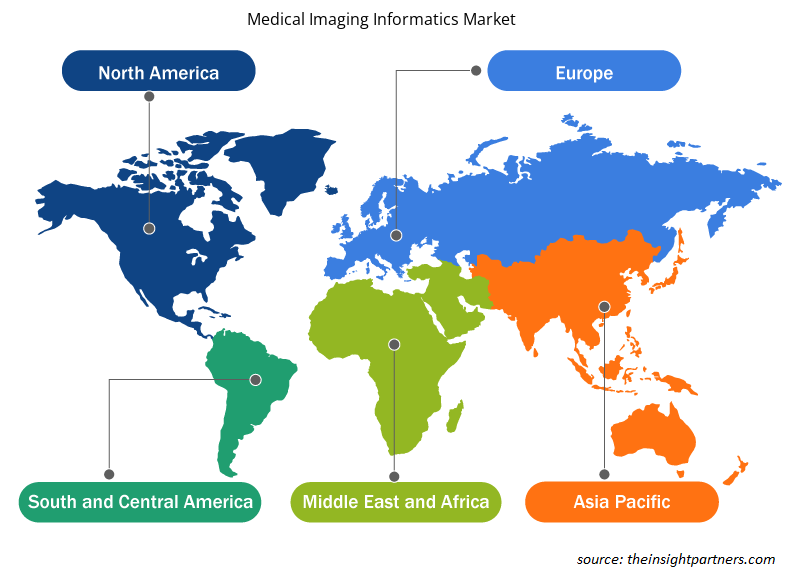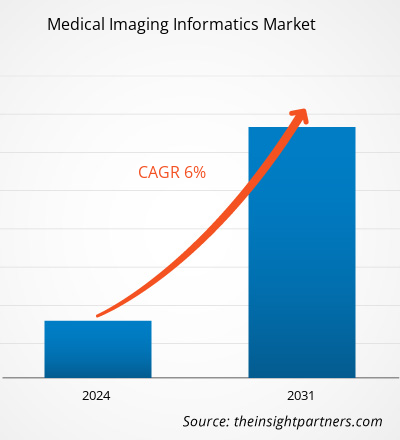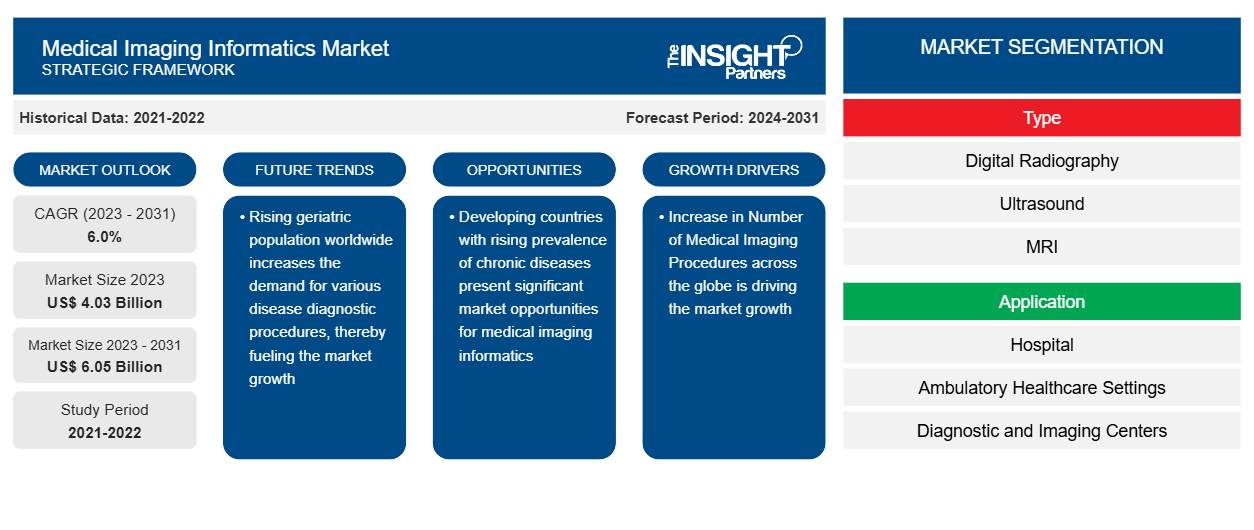La taille du marché de l'informatique d'imagerie médicale devrait atteindre 6,05 milliards de dollars américains d'ici 2031, contre 4,03 milliards de dollars américains en 2023. Le marché devrait enregistrer un TCAC de 6,0 % au cours de la période 2023-2031.La demande croissante de plateformes basées sur l’IA et le cloud restera probablement une tendance clé du marché.
Analyse du marché de l'informatique d'imagerie médicale
Les principaux facteurs à l’origine de la croissance du marché sont le nombre croissant de procédures d’imagerie médicale et l’augmentation de la population gériatrique. En outre, les progrès technologiques dans le domaine de l’informatique d’imagerie médicale ont créé des opportunités de croissance pour le marché au cours de la prochaine période de prévision.
Aperçu du marché de l'informatique d'imagerie médicale
Selon le moteur de recherche clinique Radiology Key, l'informatique d'imagerie consiste à utiliser les technologies de l'information (TI) pour fournir des services d'imagerie médicale efficaces, précis et fiables au sein d'un réseau de soins de santé. Également appelée informatique radiologique, l'informatique d'imagerie médicale est responsable du stockage, de la gestion et de l'accès aux informations et données liées aux images. L'imagerie médicale est largement utilisée dans les applications de cardiologie, d'obstétrique, de chirurgie et de gynécologie, entre autres, dans le secteur de la santé. Outre l'augmentation des diagnostics, l'accent croissant mis par les gouvernements régionaux et nationaux sur le diagnostic précoce des conditions médicales pour réduire les coûts globaux des soins de santé entraîne une augmentation du nombre de patients subissant une imagerie par résonance magnétique (IRM), une tomodensitométrie (TDM), une échographie et des examens à rayons X dans le monde entier, renforçant ainsi le besoin d'informatique d'imagerie médicale.
Personnalisez ce rapport en fonction de vos besoins
Vous bénéficierez d'une personnalisation gratuite de n'importe quel rapport, y compris de certaines parties de ce rapport, d'une analyse au niveau des pays, d'un pack de données Excel, ainsi que de superbes offres et réductions pour les start-ups et les universités.
-
Obtenez les principales tendances clés du marché de ce rapport.Cet échantillon GRATUIT comprendra une analyse de données, allant des tendances du marché aux estimations et prévisions.
Facteurs moteurs et opportunités du marché de l'informatique d'imagerie médicale
Augmentation de la population gériatrique
Le Royaume-Uni, le Canada, le Japon, la Chine, l’Inde et la Corée du Sud, entre autres économies, ont considérablement modernisé leurs installations et services de santé. En conséquence, l’espérance de vie des habitants de ces pays a augmenté, ce qui a entraîné une croissance de leur population gériatrique. Selon les données de l’OMS, en 2019, le nombre de personnes âgées de 60 ans et plus était de 1 milliard, et devrait atteindre 1,4 milliard d’ici 2030 et 2,1 milliards d’ici 2050. La population âgée souffre principalement de diverses maladies chroniques, telles que les maladies cardiovasculaires (MCV), en raison des changements structurels et fonctionnels de leur système cardiovasculaire associés au vieillissement. Le vieillissement entraîne un raidissement du cœur et des vaisseaux sanguins. Ainsi, les arythmies, ainsi que les maladies coronariennes et l’insuffisance cardiaque, sont des facteurs de risque courants chez les personnes âgées de 75 ans et plus. Dans la mise à jour statistique de 2019 sur les maladies cardiovasculaires et les accidents vasculaires cérébraux réalisée par l'American Heart Association (AAH), l'incidence des maladies cardiovasculaires était de 77,2 % chez les hommes et de 78,2 % chez les femmes de la tranche d'âge de 60 à 79 ans. En outre, l'incidence des maladies cardiovasculaires était de 89,3 % chez les hommes adultes et de 91,8 % chez les femmes adultes de 80 ans et plus. Ainsi, l'augmentation de la population gériatrique dans le monde accroît la demande de diverses procédures de diagnostic des maladies et d'informatique d'imagerie médicale, alimentant la croissance du marché.
Paysages dynamiques des soins de santé en Chine et en Inde
Les pays en développement comme la Chine et l'Inde présentent des opportunités de marché importantes pour l'informatique d'imagerie médicale. Avec la croissance démographique, l'augmentation des dépenses de santé et la prévalence croissante des maladies chroniques, la demande de technologies d'imagerie médicale avancées dans ces pays est en hausse. L'adoption de systèmes d'imagerie numérique et de solutions informatiques est en hausse en Chine et en Inde, motivée par la nécessité d'une gestion efficace des données, d'une précision diagnostique améliorée et d'une amélioration des soins aux patients. En Chine, les initiatives du gouvernement visant à moderniser l'infrastructure des soins de santé et à améliorer l'accès à des services de santé de qualité ont conduit à une adoption accrue de solutions informatiques d'imagerie médicale. La forte population du pays et l'expansion du secteur de la santé offrent un vaste marché aux fournisseurs proposant des technologies informatiques d'imagerie avancées . En Inde, le nombre croissant d'établissements de santé, associé à la prise de conscience croissante des avantages de l'imagerie numérique, stimule la demande de solutions informatiques capables de rationaliser les flux de travail et d'améliorer la prise de décision clinique. En tirant parti de ces opportunités et en répondant aux besoins spécifiques de ces marchés, les fournisseurs peuvent exploiter l'énorme potentiel de croissance offert par ces pays en développement.
Analyse de segmentation du rapport sur le marché de l'informatique d'imagerie médicale
Les segments clés qui ont contribué à l’élaboration de l’analyse du marché de l’informatique d’imagerie médicale sont le produit et l’utilisateur final.
- En fonction du type, le marché de l’informatique d’imagerie médicale est la radiographie numérique,échographie, IRM, scanner, imagerie nucléaire, mammographie. Le segment des ultrasons détenait la plus grande part de marché en 2023.
- En fonction des applications, le marché de l'informatique d'imagerie médicale est segmenté par hôpitaux, établissements de soins ambulatoires, centres de diagnostic et d'imagerie, etc. Le segment des hôpitaux détenait la plus grande part de marché en 2023.
- En fonction des composants, le marché de l'informatique d'imagerie médicale est segmenté par logiciels, matériels et services. Le segment des logiciels détenait la plus grande part de marché en 2023.
Analyse des parts de marché de l'informatique d'imagerie médicale par géographie
La portée géographique du rapport sur le marché de l’informatique d’imagerie médicale est principalement divisée en cinq régions : Amérique du Nord, Asie-Pacifique, Europe, Moyen-Orient et Afrique, et Amérique du Sud et centrale.
En Amérique du Nord, les États-Unis constituent le plus grand marché de l'informatique d'imagerie médicale. Le marché américain de l'informatique d'imagerie médicale devrait connaître une croissance significative en raison de la prévalence croissante du cancer, de la demande croissante d'imagerie diagnostique et de la croissance de la population gériatrique à travers le pays. En outre, divers développements réalisés par les principaux acteurs du marché dans le pays et l'augmentation des investissements gouvernementaux pour promouvoir l'industrie des dispositifs médicaux devraient également alimenter la croissance du marché au cours de la période de prévision.
Aux États-Unis et dans le monde entier, le cancer a un impact significatif sur la société. Les statistiques sur le cancer montrent ce qui se passe dans de grands groupes de personnes et donnent un aperçu de l'impact de la maladie sur la société au fil du temps. Selon Globocan 2020, les États-Unis ont enregistré 2 281 658 nouveaux cas de cancer, qui ont entraîné 612 390 décès. Les types de cancer les plus courants dans le pays sont le cancer du sein, le cancer du poumon, le cancer de la prostate, le cancer colorectal et d'autres. Ainsi, la prévalence croissante du cancer dans le pays devrait alimenter la demande d'outils d'imagerie médicale tels que l'échographie, l'IRM, la radiographie numérique et informatisée, etc. La demande d'informatique médicale va également prospérer au cours de la période de prévision.
Aperçu régional du marché de l'informatique d'imagerie médicale
Les tendances et facteurs régionaux influençant le marché de l’informatique d’imagerie médicale tout au long de la période de prévision ont été expliqués en détail par les analystes d’Insight Partners. Cette section traite également des segments et de la géographie du marché de l’informatique d’imagerie médicale en Amérique du Nord, en Europe, en Asie-Pacifique, au Moyen-Orient et en Afrique, ainsi qu’en Amérique du Sud et en Amérique centrale.

- Obtenez les données régionales spécifiques au marché de l'informatique d'imagerie médicale
Portée du rapport sur le marché de l'informatique d'imagerie médicale
| Attribut de rapport | Détails |
|---|---|
| Taille du marché en 2023 | 4,03 milliards de dollars américains |
| Taille du marché d'ici 2031 | 6,05 milliards de dollars américains |
| Taux de croissance annuel composé mondial (2023-2031) | 6,0% |
| Données historiques | 2021-2022 |
| Période de prévision | 2024-2031 |
| Segments couverts |
Par type
|
| Régions et pays couverts |
Amérique du Nord
|
| Leaders du marché et profils d'entreprises clés |
|
Densité des acteurs du marché de l'informatique d'imagerie médicale : comprendre son impact sur la dynamique commerciale
Le marché de l'informatique d'imagerie médicale connaît une croissance rapide, tirée par la demande croissante des utilisateurs finaux en raison de facteurs tels que l'évolution des préférences des consommateurs, les avancées technologiques et une plus grande sensibilisation aux avantages du produit. À mesure que la demande augmente, les entreprises élargissent leurs offres, innovent pour répondre aux besoins des consommateurs et capitalisent sur les tendances émergentes, ce qui alimente davantage la croissance du marché.
La densité des acteurs du marché fait référence à la répartition des entreprises ou des sociétés opérant sur un marché ou un secteur particulier. Elle indique le nombre de concurrents (acteurs du marché) présents sur un marché donné par rapport à sa taille ou à sa valeur marchande totale.
Les principales entreprises opérant sur le marché de l'informatique d'imagerie médicale sont :
- Groupe Agfa-Gevaert
- Santé Carestream
- SPA ESAOTE
- Général Électrique
- Royal Philips NV
- Siemens Healthcare GmbH
Avis de non-responsabilité : les sociétés répertoriées ci-dessus ne sont pas classées dans un ordre particulier.

- Obtenez un aperçu des principaux acteurs du marché de l'informatique d'imagerie médicale
Actualités et développements récents du marché de l'informatique d'imagerie médicale
Le marché de l'informatique d'imagerie médicale est évalué en collectant des données qualitatives et quantitatives après des recherches primaires et secondaires, qui comprennent des publications d'entreprise importantes, des données d'association et des bases de données. Quelques-uns des développements du marché de l'informatique d'imagerie médicale sont répertoriés ci-dessous :
- Philips lance de nouvelles solutions informatiques améliorées par l'IA pour accroître la confiance diagnostique grâce à l'intelligence à chaque étape du flux de travail radiologique au RSNA (Source : Philips, site Web de l'entreprise, novembre 2022)
Rapport sur le marché de l'informatique d'imagerie médicale : couverture et livrables
Le rapport « Taille et prévisions du marché de l’informatique d’imagerie médicale (2021-2031) » fournit une analyse détaillée du marché couvrant les domaines ci-dessous :
- Taille et prévisions du marché de l'informatique d'imagerie médicale aux niveaux mondial, régional et national pour tous les segments de marché clés couverts par le périmètre
- Tendances du marché de l'informatique d'imagerie médicale ainsi que dynamique du marché telles que les moteurs, les contraintes et les opportunités clés
- Analyse détaillée des cinq forces de PEST/Porter et SWOT
- Analyse du marché de l'informatique d'imagerie médicale couvrant les principales tendances du marché, le cadre mondial et régional, les principaux acteurs, les réglementations et les développements récents du marché.
- Analyse du paysage industriel et de la concurrence couvrant la concentration du marché, l'analyse de la carte thermique, les principaux acteurs et les développements récents du marché de l'informatique d'imagerie médicale
- Profils d'entreprise détaillés
- Analyse historique (2 ans), année de base, prévision (7 ans) avec TCAC
- Analyse PEST et SWOT
- Taille du marché Valeur / Volume - Mondial, Régional, Pays
- Industrie et paysage concurrentiel
- Ensemble de données Excel
Rapports récents
Rapports connexes
Témoignages
Raison d'acheter
- Prise de décision éclairée
- Compréhension de la dynamique du marché
- Analyse concurrentielle
- Connaissances clients
- Prévisions de marché
- Atténuation des risques
- Planification stratégique
- Justification des investissements
- Identification des marchés émergents
- Amélioration des stratégies marketing
- Amélioration de l'efficacité opérationnelle
- Alignement sur les tendances réglementaires























 Obtenez un échantillon gratuit pour - Marché de l'informatique d'imagerie médicale
Obtenez un échantillon gratuit pour - Marché de l'informatique d'imagerie médicale